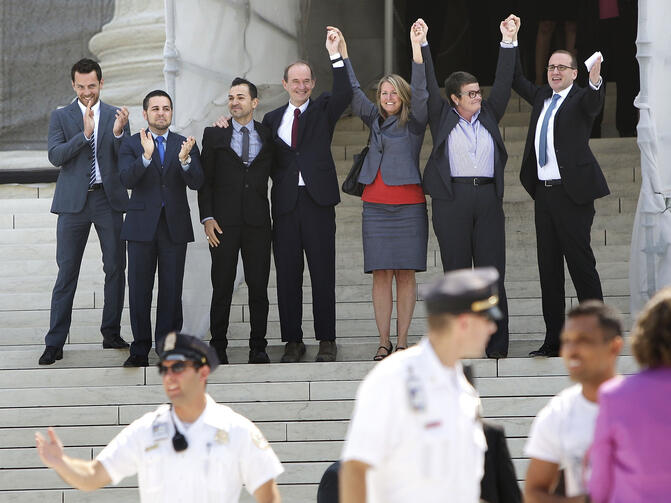On June 26, 2013, the U.S. Supreme Court decided two cases related to same-sex marriage, United States v. Windsor and Hollingsworth v. Perry. In Windsor, the U.S. Supreme Court determined that the definition of marriage set forth in DOMA, the federal Defense of Marriage Act, violated the Fifth Amendment’s due process and equal protection clauses, not because the court declared a constitutional right to same-sex marriage, but because the federal law distinguished between same-sex married couples and heterosexual married couples when the states that issued their marriage licenses made no such distinction. The decision in Perry ends a lengthy and uniquely Californian legal case that went up, down and around all levels of the state and federal courts. The U.S. Supreme Court’s decision in this case also makes no substantive pronouncement on a constitutional right to same-sex marriage. It does, however, leave in place a federal trial court decision that held Proposition 8 unconstitutional and reinstated same-sex marriage in California.
Those who contend the primacy of traditional heterosexual marriage is essential to the well being of society clearly are disheartened by these rulings ("Tragic Day for Marriage and our Nation," U.S. Conference of Catholic Bishops, June 26). Nevertheless, while the DOMA decision grants significant federal benefits to couples in legally recognized same-sex marriages, and, combined with the Prop 8 decision, will undoubtedly increase the number of married same-sex couples in the United States, the scope of the rulings are narrow and likely will have little long-term impact on the legality of same-sex marriage. The five statements set forth here serve as a guide to understanding the court’s recent decisions and the current state of U.S. marriage laws.
1. Marriage is a state law issue; the federal government is not empowered to issue marriage licenses.
The U.S. Constitution creates a federal system in which power is divided between the state and federal governments. For example, Article I enumerates the powers specifically granted to Congress while the Tenth Amendment grants residual powers to the states. The power to sanction marriages is not delegated to Congress, nor is it “necessary and proper” to an enumerated power. States exercise their authority to sanction marriages as part of their general police powers. Although DOMA defined marriage for federal purposes as “a legal union between one man and one woman,” it was not a federal marriage law. DOMA did not grant anyone the right to marry; it merely stated that the federal government would not acknowledge the legal status of same-sex couples who were married under state or foreign laws. Consequently, advocates on both sides of the marriage debate cannot look to Congress or the president to resolve the issue. The battleground is in the states and the courts.
2. United States v. Windsor declared only part of DOMA unconstitutional.
Section 3 of DOMA, which specifically excluded same-sex marriages from federal recognition, has been declared unconstitutional and no longer may be applied by federal agencies. The federal government’s unequal treatment of state-sanctioned marriages was struck down, but no state is required to issue marriage licenses to same-sex couples or give legal recognition to same-sex marriages performed in other states. Windsor specifically left intact section 2 of DOMA, which provides, “No State...shall be required to give effect to any [law] of any other State,...respecting a relationship between persons of the same sex that is treated as a marriage,” because it was not relevant to the case and had not been challenged by the parties. This provision of DOMA eventually may be overturned based on Article IV’s “full faith and credit” and “privileges and immunities” clauses, but for now, section 2 protects state DOMA statutes.
3. Hollingsworth v. Perry, the case arising out of California’s Prop 8 ballot initiative, was decided by the U.S. Supreme Court on a procedural issue that leaves undisturbed a lower court ruling that declared a constitutional right to same-sex marriage.
The story of California’s same-sex marriage law is lengthy and convoluted. In short, the push for legal recognition of same-sex couples in California goes back at least to 1985, when a few cities implemented domestic partner registries. Proponents of equal rights for same-sex couples won various victories in the legislature by passing laws that eventually bestowed virtually all marital rights on domestic partners, but opponents of same-sex marriage won in California’s unusual popular vote ballot initiatives. In 2000, one such referendum passed and created California’s version of DOMA, a state statute providing, “Only marriage between a man and a woman is valid or recognized in California.”
In May 2008, the California Supreme Court declared California’s DOMA statute in violation of the California Constitution’s equal protection clause. Opponents went to the ballot box again, but this time with a proposition amending the state Constitution. In November 2008, Prop 8, which consisted of the same language previously declared unconstitutional—“Only marriage between a man and a woman is valid or recognized in California”—passed and became part of the California constitution. The case went back to the California courts with the highest court deciding Prop 8 was valid under state law. Not to be deterred, same-sex marriage advocates took the issue to the federal courts claiming the U.S. Constitution protects what the California constitution does not, namely the right to a same-sex marriage. The federal trial court judge agreed.
While the people of the State of California voted for Prop 8, their elected officials did not support the constitutional amendment and refused to defend it in court. Once the federal trial court judge struck down Prop 8, California officials were glad to acquiesce to the court’s ruling and did not file an appeal. Usually, when one party loses at trial and chooses not to appeal, the case is over, but in this situation, the intermediate appellate court (the Ninth Circuit), relying on an advisory opinion issued by the California Supreme Court, determined that the official proponents, California citizens who had initiated and voted for Prop 8, were legally empowered to act on behalf of the state and bring an appeal in federal court. In legal parlance, the proponents had “standing,” a necessary element to satisfy the U.S. Constitution’s “case or controversy” jurisdictional requirement. The U.S. Supreme Court disagreed, ruling that neither the Ninth Circuit, nor it, the Supreme Court, could hear the appeal. Consequently, the trial court decision remains in effect, but it has no implications outside California.
4. The U.S. Supreme Court has not determined that same-sex couples have a constitutional right to marry.
As stated above, the U.S. Supreme Court did not rule on the trial court’s decision in Perry that the U.S Constitution requires states to grant identical marital benefits to both different-sex and same-sex couples. The Windsor decision similarly does not reach the question of whether same-sex couples are entitled, under the U.S. Constitution, to state-issued marriage licenses. The court in Windsor merely held that when states issue marriage licenses, the federal government must honor those licenses equally for different-sex and same-sex couples. The decision leaves the battle for and against same-sex marriage in the states, at least for now. Presumably, a challenge to the constitutionality of a state DOMA law, or a state’s refusal to issue marriage licenses to same-sex couples, will be heard by the U.S. Supreme Court on its merits and the issue will finally be decided; but the Supreme Court has the luxury of selecting which cases it will hear. For now then, the states’ rights democratic process urged by the United States Conference of Catholic Bishops in its amicus curiae (friend of the court) brief in the Perry case prevails. “[T]he Court should not foreclose varying judgments by the citizenry by forcing the issue into a constitutional Procrustean bed.” (Hollingsworth v. Perry, Brief Amicus Curiae of United States Conference of Catholic Bishops in Support Of Petitioners And Supporting Reversal.)
5. The fate of same-sex marriage in the United States will be determined based on the U.S. Supreme Court’s understanding of due process and equal protection.
Marriage rights advocates on both sides of the issue must, for the present, direct their energies to state legislative initiatives, but the question of whether the Constitution grants same-sex couples a right to marry most likely will be answered by the U.S. Supreme Court. The relevant section of the Fifth Amendment states, “No person shall...be deprived of life, liberty, or property, without due process of law.” The relevant section of the Fourteenth Amendment reads: no state shall “deprive any person of life, liberty, or property, without due process of law; nor deny to any person within its jurisdiction the equal protection of the laws.” These constitutional provisions were applied to strike down Virginia’s anti-miscegenation laws. In Loving v. Virginia (1967), a unanimous Supreme Court held:
There can be no doubt that restricting the freedom to marry solely because of racial classifications violates the central meaning of the Equal Protection Clause. These statutes also deprive the Lovings of liberty without due process....The freedom to marry has long been recognized as one of the vital personal rights essential to the orderly pursuit of happiness by free men.
Laws that effect disparate treatment based on race are always suspect and, if they can be justified at all, must withstand the strictest scrutiny. No one knows what level of scrutiny, if any, the Supreme Court will apply to disparate treatment based on the sexes of a couple. In Baker v. Nelson (1972), the court did not decide and, thus, let stand, a Minnesota Supreme Court ruling that held there is no constitutional right to same-sex marriage. In Romer v. Evans (1996), however, the court declared unconstitutional a Colorado law that prohibited all government protection of gays, lesbians and bisexuals. Justice Kennedy, who also wrote the majority opinion in Windsor, stated, “if a law neither burdens a fundamental right nor targets a suspect class, we will uphold the legislative classification so long as it bears a rational relation to some legitimate end. [The Colorado law] fails, indeed defies, even this conventional inquiry.”
More recently, in 2008, the Supreme Court held unconstitutional a Texas sodomy statute that criminalized homosexual, but not heterosexual conduct (Lawrence v. Texas, 2003). The court found a due process liberty right to engage in private sexual conduct and held Texas had no legitimate interest to interfere with that right. While Justice Kennedy, again writing for the majority, acknowledged the changing nature of constitutionally protected liberty interests, Justice O’Connor, in a concurring and, thus, non-binding opinion, recognized the distinction between protected sexual conduct and the right to marry. “That this law as applied to private, consensual conduct is unconstitutional under the Equal Protection Clause does not mean that other laws distinguishing between heterosexuals and homosexuals would similarly fail under rational basis review. Unlike the moral disapproval of same-sex relations—the asserted state interest in this case—other reasons exist to promote the institution of marriage beyond mere moral disapproval of an excluded group.”
While proponents of same-sex marriage celebrate the Windsor and Perry decisions, the battle over same-sex marriage is far from over. These decisions, with their 5 to 4 rulings, and strongly worded dissenting opinions, indicate just how divided we, as a nation, are when it comes to who may utter those simple words, “I do.”








